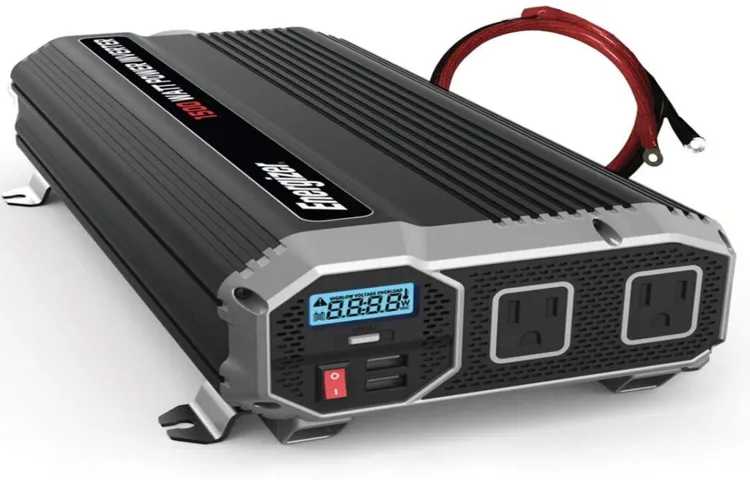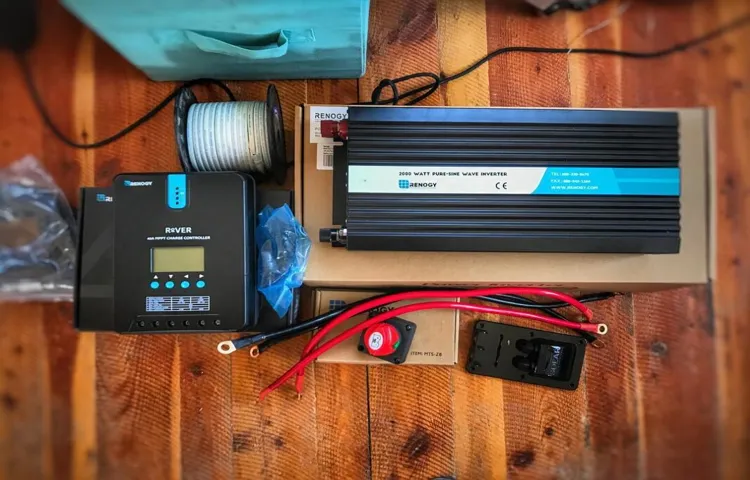Have you ever found yourself needing to power your electronic devices while on the go, only to discover that you don’t have the right tools? Whether you’re going camping, traveling in an RV, or simply need a backup power source during a power outage, a power inverter can be a lifesaver. But with so many options available, how do you choose the right one? One of the most crucial factors to consider when selecting a power inverter is the number of watts you’ll need. Watts are a measure of a device’s power consumption, and choosing the right wattage is essential for ensuring that your inverter can handle the load.
Too little wattage, and your inverter won’t be able to power your devices effectively; too much, and you might end up overspending on an unnecessarily powerful inverter. So, how do you determine how many watts you need? The answer lies in understanding the power requirements of the devices you plan to connect to your inverter. Each device has its own power rating, usually listed in watts or amps.
By adding up the power ratings of all the devices you want to power simultaneously, you can get an idea of the minimum wattage your inverter should have. It’s also crucial to consider any power surges or start-up currents your devices might have. Some devices, like refrigerators or air conditioners, require a surge of power when they first turn on.
To account for this, you might need an inverter with a higher wattage to handle these temporary spikes in power demand. Choosing the right power inverter is like finding the right-sized wrench for a specific bolt. You need to have the right tool for the job, or else it won’t work properly.
By accurately assessing the power requirements of your devices and anticipating any surges or start-up currents, you can ensure that you choose an inverter with the appropriate wattage. In conclusion, choosing the right power inverter involves understanding the power requirements and potential surges of the devices you plan to connect. By accurately calculating the wattage needed, you can avoid the frustration of an underpowered or overpowered inverter.
So, before your next adventure, take the time to evaluate your power needs and make an informed decision. Your electronic devices will thank you!
Table of Contents
Understanding Power Inverters
When it comes to choosing a power inverter, one important factor to consider is the wattage. The wattage of a power inverter determines how much power it can supply. To figure out how many watts your power inverter should be, you need to consider the wattage requirements of the devices you plan to power.
Start by making a list of all the devices you want to plug into the inverter. Then, look at the labels or user manuals of these devices to find their wattage rating. Add up the wattage of all the devices to get the total wattage requirements.
It’s important to note that the power inverter should have a wattage rating higher than the total wattage requirements to ensure that it can handle the power load without overloading or overheating. Additionally, it’s always a good idea to leave some extra headroom in case you add more devices in the future or if the devices have power spikes during startup. By choosing a power inverter with the right wattage, you can ensure that all your devices will work properly and efficiently.
What is a power inverter?
power inverter, understanding power inverters A power inverter is a device that converts DC (direct current) electricity into AC (alternating current) electricity. This means that it takes the power from a battery or other DC power source and transforms it into the type of electricity that is used in most household appliances and electronics. Power inverters are commonly used in situations where there is no access to grid electricity, such as in remote areas or during power outages.
They are also used in vehicles, such as cars and RVs, to convert the DC power from the battery into AC power for charging devices and running appliances. Understanding how a power inverter works can be a bit confusing at first. Essentially, it uses electronic components and circuitry to change the direction of the electrical current.
DC electricity flows in a straight line from the positive terminal to the negative terminal, while AC electricity alternates back and forth in a sinusoidal pattern. The power inverter takes the DC electricity and uses a series of switches to create an artificial AC waveform that mimics the electricity from the grid. This allows it to power devices that require AC electricity, such as laptops, televisions, refrigerators, and power tools.
Power inverters come in various sizes and capacities, depending on the amount of power they are designed to handle. Some are small and portable, designed for charging phones and other small electronic devices, while others are larger and more powerful, capable of running multiple appliances at once. When choosing a power inverter, it is important to consider the capacity and quality of the inverter, as well as the power requirements of the devices you plan to use with it.
In conclusion, power inverters are a crucial component for anyone who needs to convert DC power into AC power. They are versatile devices that can provide electricity in a variety of situations, from remote locations to emergency power outages. By understanding how they work and choosing the right one for your needs, you can ensure that you have a reliable and efficient source of power when you need it most.

Why do you need a power inverter?
power inverter Have you ever been in a situation where you desperately needed to charge your laptop or phone, but there was no power outlet in sight? Or maybe you were out camping and wanted to use your kitchen appliances, but there was no electricity available? That’s where a power inverter comes in handy! A power inverter is a device that converts the DC power from your vehicle’s battery into AC power that can be used to run your electronic devices. It essentially allows you to have portable electricity wherever you go. But why would you need a power inverter in the first place? Well, think about all the times when you’ve needed to charge your phone or laptop on the go.
Whether you’re on a road trip, camping, or simply stuck in traffic, having a power inverter ensures that you can stay connected and powered up. It’s like having your own personal generator with you at all times. Plus, power inverters are not just limited to charging small devices.
Some power inverters have enough wattage to power larger appliances like refrigerators, air conditioners, and power tools. So whether you’re on the road or off the grid, a power inverter is a versatile and essential tool to have.
How do power inverters work?
power inverters, work, understanding power inverters
Calculating Your Power Inverter Wattage
When it comes to choosing the right power inverter for your needs, it’s important to consider how many watts it should be. The wattage of a power inverter determines how much power it can provide to the devices you want to power. To calculate the required wattage, you need to determine the total power consumption of the devices you want to use simultaneously.
This can be done by adding up the wattage of each device. It’s always a good idea to add a margin of safety to ensure you have enough power. So, if the total wattage of your devices is 500 watts, you might want to get a power inverter with a wattage rating of at least 600 watts to account for any fluctuations or unexpected power needs.
What devices will you be running?
power inverter wattage, devices, calculating
Determine the total watts needed
power inverter wattage
Consider the start-up surge power
When it comes to choosing a power inverter for your needs, it’s important to consider the start-up surge power. This surge power refers to the extra power required by certain devices when they first start up. For example, appliances like refrigerators and air conditioners often require more power to start up than they do to run continuously.
If you don’t take this into account when choosing a power inverter, you run the risk of not being able to power your devices effectively. Calculating your power inverter wattage involves factoring in both the continuous power requirement and the surge power requirement of your devices. By doing so, you can ensure that your power inverter can handle the initial surge of power needed to start up your devices, while still providing continuous power for them to operate.
So, the next time you’re shopping for a power inverter, don’t forget to consider the start-up surge power!
Determining the continuous power draw
power inverter wattage
Choosing the Right Power Inverter Wattage
When it comes to choosing the right power inverter wattage, it’s important to consider the specific needs of your devices. The wattage of a power inverter determines how much power it can convert from DC (direct current) to AC (alternating current). To determine the wattage you need, start by listing all the appliances and devices you plan to power with the inverter.
Consider their power requirements, which are usually listed on their labels or in their user manuals. Add up the wattage of all the devices, making sure to account for any power surge or startup requirements. This total will give you an idea of the minimum wattage you should look for in a power inverter.
However, it’s always a good idea to choose an inverter with a slightly higher wattage to allow for future expansion or to handle unexpected power needs.
Use the total watts needed as a guide
power inverter wattage, choosing the right power inverter wattage, total watts needed
Considerations for future growth
Choosing the Right Power Inverter Wattage for Future Growth When it comes to planning for future growth and expansion, choosing the right power inverter wattage is crucial. A power inverter is a device that converts DC power from a battery into AC power that can be used to power various electrical devices. The wattage of a power inverter determines how much power it can handle, and it’s important to select a wattage that is capable of meeting your current needs while also allowing for future growth.
One of the most important factors to consider when choosing the right power inverter wattage is the maximum power requirement of your electrical devices. To determine this, you’ll need to assess the wattage of all the devices you plan to power with the inverter. It’s always a good idea to add a bit of a buffer to account for any potential power surges or fluctuations.
Another consideration for future growth is the scalability of your power inverter system. If you anticipate adding new devices or expanding your energy needs in the future, it’s important to choose a power inverter that can be easily upgraded or expanded. This will save you both time and money down the line, as you won’t have to replace the entire system when your power needs increase.
Additionally, it’s important to consider the efficiency of the power inverter. Higher efficiency inverters will convert more of the DC power from your battery into usable AC power, reducing waste and increasing overall energy efficiency. This can have a significant impact on your energy consumption and costs, especially as your power needs grow.
In conclusion, choosing the right power inverter wattage is a critical consideration for future growth and expansion. By assessing your current power needs, planning for future growth, and considering the scalability and efficiency of the power inverter system, you can ensure that you have the right equipment in place to meet your energy needs both now and in the future.
Factors that may affect power inverter performance
When it comes to choosing the right power inverter wattage for your needs, there are a few key factors to consider. One of the most important factors is the type of devices you plan on using with the inverter. Different devices have different power requirements, so it’s crucial to choose an inverter that can handle the wattage of the devices you plan on using.
For example, if you plan on using a laptop and a smartphone with your inverter, you may only need a lower wattage inverter. However, if you plan on using power-intensive devices like a microwave or a power tool, you will need a higher wattage inverter. It’s also important to consider the voltage of your power source and the efficiency of the inverter.
By choosing the right power inverter wattage, you can ensure that your devices will work properly and efficiently without putting too much strain on the inverter.
Conclusion
In the electrifying quest to determine the ideal number of watts for a power inverter, one must embark on a journey of knowledge and calculation. Like the conductor of an electric symphony, a power inverter transforms the energy from your vehicle’s battery into usable electrical power, allowing you to bring the comforts of civilization on your nomadic adventures. The answer to this riddle lies in the wattage requirements of your precious electronic devices.
Whether you wish to power a modest lightbulb for a cosy camping trip or an entire glamping setup complete with a mini-fridge, the key is to assess the energy demands of each item. Picture this: you’re sitting comfortably in your recreational vehicle, enjoying the hum of your portable blender as it effortlessly whips up a refreshing smoothie. Suddenly, a surge of electrical bliss courses through you, only to be quickly extinguished by the unforgiving reality of an overloaded power inverter.
Clearly, this was not the harmonious symphony of power you envisioned. To avoid such a dissonant and potentially dangerous situation, it is indispensably vital to add up the wattage ratings of all the devices you intend to power simultaneously. Remember, dear traveler, not all devices are created equal! Some may require an initial surge of power (like that pesky blender), while others may have a steady demand.
In the grand symphony of electrical preservation, a general rule of thumb is to select a power inverter with a wattage rating slightly higher than the total sum of your device’s power requirements. This creates a safety margin, ensuring the inverter will not unwittingly retire on you right in the middle of that captivating Netflix binge. But wait! There’s more! Consider the environment in which your inverter will be performing its electrifying masterpiece.
If you plan to take your power-hungry apparatus to higher altitudes or hotter climates, anticipate a drop in efficiency. In these circumstances, it’s wise to select an inverter with a higher wattage rating to compensate for the potentially diminished output. So, dear adventurer, armed with this newfound knowledge, go forth and conquer your portable power conundrums with the wit and ingenuity of a practiced electrician.
Just remember, a stronger power inverter means you’ll have more watts at your fingertips, so choose wisely and let the sparks of adventure fly!”
FAQs
How do I calculate the size of power inverter I need?
To calculate the size of power inverter you need, you should consider the wattage of the devices you plan to run. Add up the wattage of all the devices you will be using simultaneously, and choose an inverter that can handle that total wattage plus a little extra for safety.
What factors should I consider when selecting a power inverter?
When selecting a power inverter, you should consider the wattage requirements of your devices, the input voltage of your battery, the efficiency of the inverter, the wave form output, and the safety features provided.
Can I use a power inverter to run sensitive electronics?
Yes, you can use a power inverter to run sensitive electronics, but you should choose an inverter with a pure sine wave output. This will provide clean and stable power, which is important for the proper functioning of sensitive electronics.
How long can a power inverter run on a battery?
The runtime of a power inverter on a battery depends on the capacity of the battery and the power consumption of the devices connected to the inverter. You can calculate the runtime by dividing the battery capacity by the power consumption of the devices.
Can a power inverter drain my vehicle’s battery?
Yes, a power inverter can drain your vehicle’s battery if you run it for an extended period of time without the vehicle’s engine running. It is recommended to keep the vehicle’s engine running or connect the inverter to an external battery to avoid draining the vehicle’s battery.
What kind of power inverter should I use for a recreational vehicle (RV)?
For an RV, it is recommended to use a power inverter with a high wattage capacity to handle the power demands of various appliances in the RV. Additionally, an inverter with a pure sine wave output is ideal for running sensitive electronics in the RV.
Can a power inverter be used with solar panels?
Yes, a power inverter can be used with solar panels to convert the DC power generated by the solar panels into AC power that can be used to run appliances. It is important to choose an inverter that is compatible with your solar panel system.



